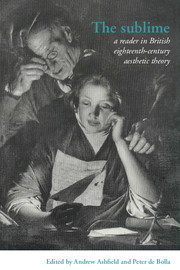Book contents
- Frontmatter
- Contents
- List of Abbreviations
- Introduction
- Part I The Longinian tradition
- Part II Rhapsody to rhetoric
- Part III Irish Perspectives
- Part IV The Aberdonian Enlightenment
- 28 An enquiry into the life and writings of Homer (1735)
- 29 Theodorus: a dialogue concerning the art of preaching (1752)
- 30 An essay on taste (1759)
- 31 An essay on original genius (1767)
- 32 Essays on the intellectual powers of man (1785)
- 33 Dissertations moral and critical (1783)
- Part V Edinburgh and Glasgow
- Part VI From the Picturesque to the Political
- Sources and further reading
30 - An essay on taste (1759)
Published online by Cambridge University Press: 05 June 2012
- Frontmatter
- Contents
- List of Abbreviations
- Introduction
- Part I The Longinian tradition
- Part II Rhapsody to rhetoric
- Part III Irish Perspectives
- Part IV The Aberdonian Enlightenment
- 28 An enquiry into the life and writings of Homer (1735)
- 29 Theodorus: a dialogue concerning the art of preaching (1752)
- 30 An essay on taste (1759)
- 31 An essay on original genius (1767)
- 32 Essays on the intellectual powers of man (1785)
- 33 Dissertations moral and critical (1783)
- Part V Edinburgh and Glasgow
- Part VI From the Picturesque to the Political
- Sources and further reading
Summary
Part I. Taste resolved into its simple principles
Section II. Of the sense or taste of grandeur and sublimity
Grandeur or sublimity gives us a still higher and nobler pleasure, by means of a sense appropriated to the perception of it; while meanness renders any object, to which it adheres, disagreeable and distasteful. Objects are sublime, which possess quantity or amplitude, and simplicity in conjunction.
Considerable magnitude or largeness of extension, in objects capable of it, is necessary to produce sublimity. It is not on a small rivulet, however transparent and beautifully winding; it is not on a narrow valley, though variegated with flowers of a thousand pleasing hues; it is not on a little hill, though clothed with the most delightful verdure, that we bestow the epithet sublime: but on the Alps, the Nile, the ocean, the wide expanse of heaven, or the immensity of space uniformly extended, without limit or termination.
We always contemplate objects and ideas with a disposition similar to their nature. When a large object is presented, the mind expands itself to the extent of that object, and is filled with one grand sensation, which totally possessing it, composes it into a solemn sedateness, and strikes it with deep silent wonder and admiration: it finds such a difficulty in spreading itself to the dimensions of its object, as enlivens and invigorates its frame: and having overcome the opposition which this occasions, it sometimes imagines itself present in every part of the scene, which it contemplates; and, from the sense of this immensity, feels a noble pride, and entertains a lofty conception of its own capacity.
- Type
- Chapter
- Information
- The SublimeA Reader in British Eighteenth-Century Aesthetic Theory, pp. 168 - 172Publisher: Cambridge University PressPrint publication year: 1996
- 3
- Cited by



